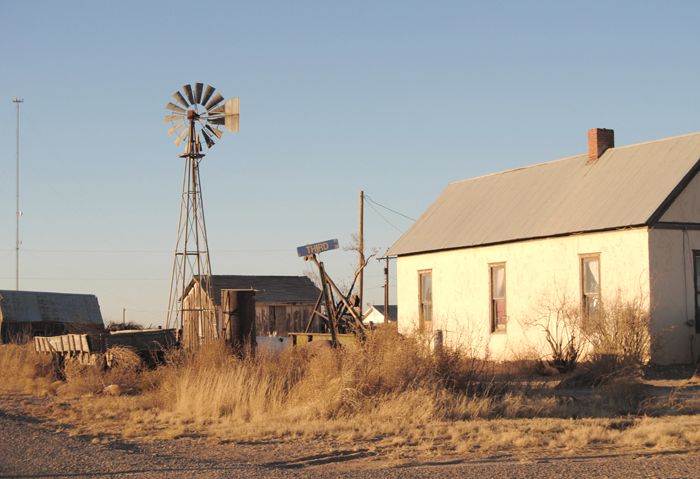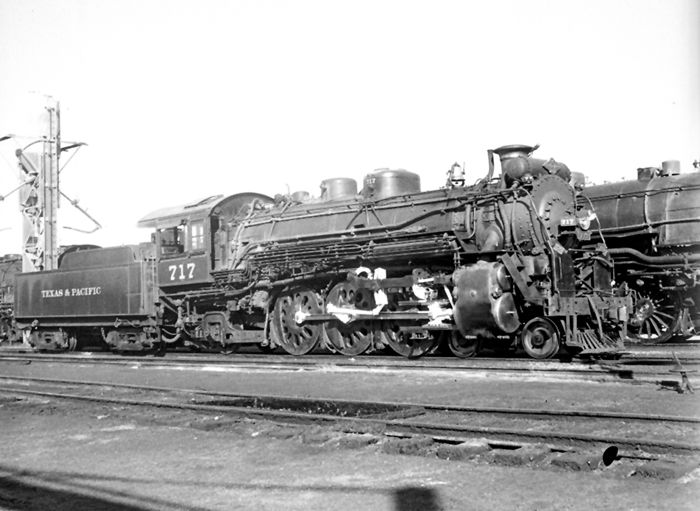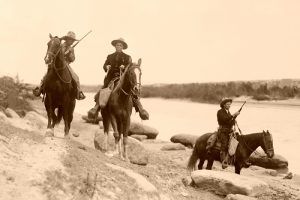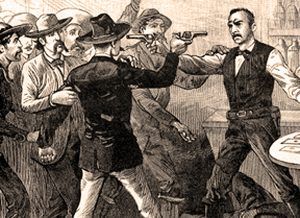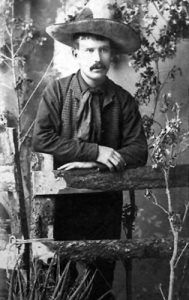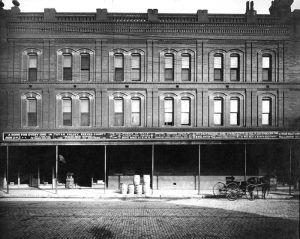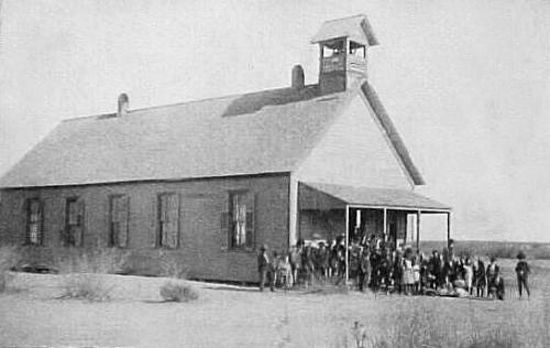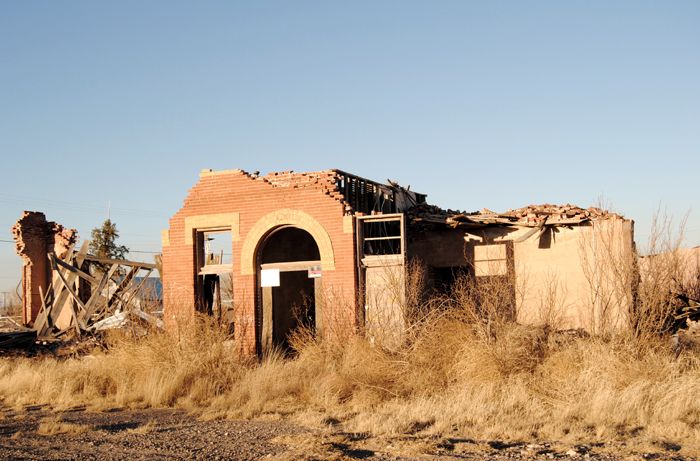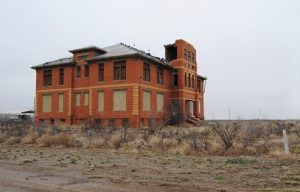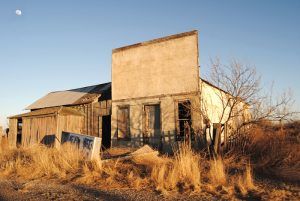Toyah, Texas, the oldest town in Reeves County, was once a hub along the Texas & Pacific Railroad. Today, it is a sparsely populated ghost town with numerous abandoned buildings standing in various states of decay.
The town got its start as a trading post for the large ranches in the area and took its name from an Indian word meaning “flowing water,” probably due to several artesian springs in the area.
It began when a man named W. T. Youngblood moved his family to the area from Midland in 1879. Arriving in a covered wagon, Youngblood also brought a stock of general merchandise. He first opened a tent store in Toyah and began to travel as a peddler between the local ranches to sell his wares. He soon saved enough money to build a one-room store of adobe, which became a gathering spot for the area ranchers.
By 1880 the Texas and Pacific Railway was building tracks through Reeves County bringing more people to the area. At that time, section houses, a roundhouse, and shops were constructed at Toyah. The first train arrived in 1881, changing the town drastically. A post office opened the same year and the Overland Stage Company began to make runs to Fort Davis and Fort Stockton six times each way weekly. By October 20, 1881, Toyah was described as a town of tents, saloons, and restaurants. Water was hauled from Monahans and sold by the barrel. The town soon became a shipping point for local ranchers. In 1882, cattle shipping and the numerous area ranches brought cowboy-detective Charles Siringo to the area to look for and capture rustlers.
In the meantime, the Youngblood Trading Post was enlarged to become both a mercantile and a hotel. Additional space, living quarters, a lobby, and a dining room were added. By 1886 the community also included the A. M. Fields Hotel, along with more saloons and restaurants.
During these early years, Toyah, like many other places in the West, was a rough and tumble town. In 1885, Texas Ranger Captain James T. Gillespie established a camp for Company E at Toyah. In the early evening of August 18, 1885, Reeves County Sheriff, J. T. Morris, who was known to be a hard drinker and who had previously been verbally abusive to the captain, arrived in Toyah on the train from Pecos. Already drunk when he arrived, the sheriff was allegedly there to kill a man named Jep Clayton. Upon his arrival, he demanded that the Texas Rangers furnish him a pair of mules and a buggy and when Captain Gillespie refused, Morris began making abusive remarks and was quoted as saying, “I run Pecos and damned if I don’t run Toyah.”
He then stomped away, waving his cocked six-shooter around, and made his way to the Favorite Saloon. There, Morris continued to drink and when he became abusive with the other patrons, someone notified the Rangers. Captain Gillespie then sent Ranger Sergeant Cartwright, Corporal William S. Hughes, and Privates Frank W. DeJarnette and Thomas P. Nigh to arrest and disarm the sheriff without hurting him if possible.
The four rangers found Morris in the saloon, cursing and waving his pistol around. When Cartwright ordered Morris to give up his gun and surrender, the sheriff fired at him but missed. He then fired a second shot hitting Private Nigh and killing him instantly. The Rangers returned fire, hitting the sheriff five times in the chest. Sam Lane, the proprietor of the saloon was also shot in both legs during the exchange. Morris held on for a short time and was taken to the Field Hotel, where he died within a very short time. Private Thomas P. Nigh was buried by the Rangers at Toyah but his grave is lost today.
In the meantime, Toyah continued to grow and the first public school was established in 1894 with one teacher and five grades in a one-room building. A few years later it would have 42 students and two teachers.
In 1896, another violent killing occurred in a saloon in Toyah. In September, George A. “Bud” Frazer, a former Texas Ranger and Reeves County Sheriff, was visiting family in Toyah. For the previous several years, he had been involved in a bloody feud with “Killin” Jim Miller, who had served as the Pecos City Marshal. After several people had been killed and Frazer lost the sheriff’s election in 1894, he moved to New Mexico. However, the feud wasn’t over and when Miller heard that Frazer was back in Texas, he was determined to end the feud.
On the morning of September 14th, when Bud was playing cards with friends in a saloon, Miller pushed open the door and fired with both barrels, practically blowing Frazer’s head from his body. When Bud’s distraught sister approached Miller with a gun, he said to her: “I’ll give you what your brother got — I’ll shoot you right in the face!” Afterward, James Miller was acquitted of the murder of Bud Frazer, his defense being “he had done no worse than Frazer.” However, Miller, who had led a life of crime and murder, would later meet his just end when he was hanged by vigilantes in Ada, Oklahoma on April 6, 1909.
On October 25, 1906, violence erupted again when a black man named “Slab” Pitts was hanged in Toyah. Just a few days earlier, Pitts had arrived in town from Roswell, New Mexico. There, he had served 90 days in jail for a violation of the Edmunds Act, an Anti-Polygamy law. Interestingly, the newspapers don’t mention more than one wife, rather, they only state that he was married to a white woman named Eva Pitts. After he was released from jail in Roswell, he was run out of town and arrived in Toyah with his “accomplice,” Eva Pitts.
But Slab had most definitely chosen the wrong town to come to with his white wife. Years earlier, when Toyah was first established, the town had barred African Americans from living there or anywhere within a radius of 180 miles. Only days after the couple arrived, a large mob of cowboys descended upon the house they were living in at night and pulled Pitts from his bed. They placed a rope around his neck and dragged him to the nearest telegraph pole, and hanged him from the cross-arm. His crime was miscegenation – marrying a white woman.
By 1910 the town reached its peak population of 1,052 and had four churches, four stores, two banks, two hotels, two lumber yards, and a drugstore. In 1912, a large brick school building was constructed that served as both an elementary and high school.
A short time later, however, Toyah lost its shipping business to a new point on the line at Toyahvale, which was closer to the ranches. However, Toyah was able to sustain most of its population for several years due to the discovery of shallow oil fields in the area. But, with the start of the Great Depression, its population rapidly declined and by 1930, its population was just 553. At that time, it still boasted 17 businesses including a bank. Even though the community’s population was reduced, the town incorporated in 1933 and its number of businesses rose to 20.
Afterward, the population continued to drop. The bank closed in the late 1930s and the Hart Grocery in the early 1940s. By 1950, Toyah’s population dropped to 409 and by 1980 it had decreased to just 165.
Over the years, floods and high winds took their toll on many of the town’s buildings, and in April 2004, storms delivered eight inches of rain in about two hours. The dike that had been built to protect the town gave way due to the volume of water, flooding nearly every building in town. At some point, the Toyah school district was consolidated with the Pecos school district.
Though Toyah still supports a population of about 90 people and still has a post office, it is a shell of its former self today. Many of its original buildings are gone and most of the others are abandoned.
Toyah is located 21 miles southwest of Pecos, Texas just off Interstate Highway 20.
Also See:
Bud Frazer and the Frazer-Miller Feud
Texas Ghost Towns Photo Galleries
Sources:
Officer Down
Pecos Enterprise
Texas Escapes
Texas State Historical Association

